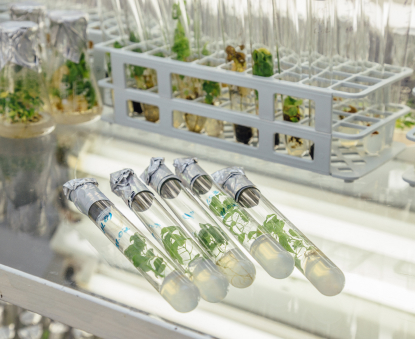Biotechnology
Improving on nature

GENE EDITING
A range of precise genome-editing techniques have been developed that are now being routinely applied to inactivate or redesign gene functions at the genome level. These technologies are based on the use of engineered nucleases composed of sequence-specific DNA-binding domains fused to a DNA cleavage molecule. They allow precise genetic modifications to be made by inducing DNA double-stranded breaks in the targeted region that stimulate the cell’s own DNA repair mechanisms via homologous recombination. They effectively work like scissors, cutting the DNA in a specific location (recognised by the DNA-binding domain), then removing, adding, or replacing it with known DNA sequences where the cut was made.
The most used techniques in genome editing are CRISPR/Cas9 (Clustered Regularly Interspaced Short Palindromic Repeats with associated Cas9 protein), TALENs (Transcription Activator-Like Effector Nucleases), and ZFNs (Zinc-Finger Nucleases).
Gene editing is not only a more precise and efficient tool than induced mutation for inactivating genes, it enables the ‘upgrading’ of high-performance crop varieties without the disruption to the background genotype that occurs through traditional and mutation breeding approaches. Gene editing provides a powerful new capability for in situ redesign of genes to achieve directed metabolic changes, such as in fatty acid and oil biosynthesis.
The first commercial applications of gene editing of plant oils involved the development of high-oleic soybeans by editing the Fad2-1A and Fad2-1B genes. These genes are responsible for most of the conversion of oleic acid (18:1) to linoleic (18:2) acid in the developing soybean seed and are not expressed in the rest of the plant. This enabled the enzyme to be inactivated by editing the DNA sequence at the genomic level without causing any undesirable side effects on plant performance.
In this way, the US company Cellectis Plant Science Inc. used its proprietary TALEN gene-editing technology to create a soybean producing an oil containing 78% oleic acid and having normal agronomic performance. The first commercial sale of the high-oleic oil, branded as Calyno, occurred in 2019. Subsequently, Calyxt Inc (formerly Cellectis) further improved the oil profile by gene editing of the Fad3 gene to reduce linolenic acid (18:3) content and further raise oleic acid to 82%. This improved high-oleic low-linolenic (HOLL) soybean is scheduled to be commercially released in the US in 2022.
As they resulted from gene-editing technology that did not incorporate any foreign genes into the product, both modified soybean oils were approved by USDA as non-regulated articles (effectively a ‘non-GM’ status).
<-- More Biotechnology -->

PLANT BREEDING
Conventional plant breeding involves controlled pollination followed by generations of selection within progeny for desired combinations of traits.

MUTAGENESIS
Where natural variation is insufficient to achieve the desired trait, mutagenic treatments may be used to create additional genetic variation.

TRANSFORMATION
New DNA can be introduced to create GM plants with desired genetic traits, using either biolistics (gene-gun) or Agrobacterium transformation.

GENE SILENCING
A targeted gene can be ‘silenced’ by introducing a construct that triggers degradation of the gene’s message, preventing its translation into protein.

GENE EDITING
Genes can be enhanced or inactivated by using ‘molecular scissors’ to replace or remove short sequences of DNA at highly specific locations.

GENE ADDITION
Plants can be engineered to make new products by incorporating novel gene sets that encode specific enzymes or entire metabolic pathways.

